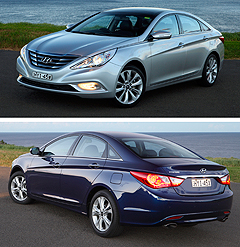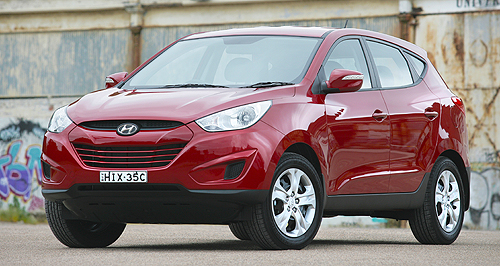News - Hyundai - ix35Customers queue for Hyundai ix35Waiting list: Hyuindai says customers are willing to wait up to three months for its ix35 SUV. Hyundai’s Tucson replacement lifts the brand’s image – and willingness to pay for it14 Jul 2010 By IAN PORTER WHAT looked an impossible dream for Hyundai just 12 months ago appears to be coming true in Australia, with customers new to the brand willing to pay up to $9000 more than before for one of its Korean-made products. And, what’s more, they are prepared to wait up to three months for the privilege, according to Hyundai Motor Corporation Australia (HMCA) chief executive Edward Lee. Speaking before the launch of the Indian-made i20 city car, Mr Lee said the company’s replacement for the Tucson softroader, the ix35, had prompted a strong reaction from buyers. “Customers are waiting two to three months for an ix35,” Mr Lee said, before adding that Australia simply cannot obtain any more units at present. “The car is a success everywhere. The global demand means there are waiting lists. “Our dealers tell me people are willing to wait for an ix35. They say that is quite unusual for a Hyundai product.” Supply is constrained at the Korean plant, and Mr Lee indicated that production was unlikely to be increased within 12 months.  Left: Hyundai i45. Left: Hyundai i45.Still recovering from a marathon stint thanks to Hyundai’s key sponsorship role for the soccer World Cup and a decision to watch the final at the Darling Harbor crowd centre at 3am, Mr Lee said Australia was scouring the world looking for extra supply that might be available by diverting product to Australia. He has been frank in the past about the need for Hyundai products to shed the “cheap and cheerful” image built up in the days when the Excel created havoc in the small car market with super-low drive-away prices. The company’s aim in the last decade has been to lift the design and quality of its products so that people would be prepared to buy them even when they were pitched at normal price points. The success of the ix35 indicates that Hyundai may be on the right track, even though it cannot obtain sufficient product to meet demand. “The old Tucson used to sell 1000 a month, but we can only get 800 ix35s now,” he said. “I think we could sell 1200 a month if we could get supply.” He said head office was already asking its international distribution arms how many ix35s they think they can sell in three years’ time, before deciding on how much to expand output. However, Mr Lee’s frustration at not being able to meet demand is being partly offset by the rich mix of ix35 sales. He said an unexpectedly high proportion of ix35 sales were the most expensive Highlander model. “The transaction price is between $7000 and $9000 more for an ix35 than they were paying for the Tucson,” he said. When the softroader was launched in February, Hyundai was unsure if the $1500 price hike to $26,990 for the entry level ix35 versus the entry level Tucson would deter people. Buyers have apparently shrugged off the price hike. “Our new product is quite different from before and it is attracting new people to the showroom,” Mr Lee said. “Even with the higher price, they see the value.” Mr Lee said Hyundai was also having problems meeting demand for the recently released i45 sedan, although it was still early days. “It’s not as difficult as with the ix35. It might take two or three months to catch up,” he said. “It has been very well received and it won a design award.” The i45 was one of three cars to win in the automotive and transport category of the Australian International Design Awards announced in June. “Customer surveys show they are very happy with the car. They like the design, the performance, the package. Almost everything, they love.” He said the i45 was also bringing new buyers into the showrooms. “They are wealthier buyers, of course.” Perhaps taking a lesson from the ix35 experience, Hyundai jacked up the entry level price for the i45 almost 10 per cent from $27,990 for the Sonata to $29,490 for the base i45. “It is attracting different people to the showroom. Even with the higher price, they see the value.” Mr Lee said management was still considering whether to add a diesel i45 to the range. “Diesel is growing. It is a very important market. We have good diesel technology.” But Mr Lee indicated that Hyundai had no room in its busy 2010 schedule for any extra activity. “We have too many products to bring at this moment. “We are more than enough busy. Actually, we are too busy.” Whenever he spoke with Hyundai dealers, they asked about the company’s future plans and Mr Lee said he always asks them to be ready for the future. “Dealers have to be ready for the future. Other than that, there will be no future.” Hyundai has set its sights on achieving a 10 per cent market in Australia by 2012, indicating that it would be selling around 100,000 vehicles a year. Last year it sold a record 63,207 vehicles in Australia. Mr Lee said the burden on dealers to invest for the extra volume they will be handling was being softened by the more costly models they are now selling. “They have more expensive product. Their total revenue is growing faster than their volume. “They will be able to invest in time for the increased market share,” he said.  Read more |
Click to shareHyundai articlesResearch Hyundai Motor industry news |

















Facebook Twitter Instagram